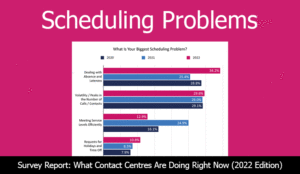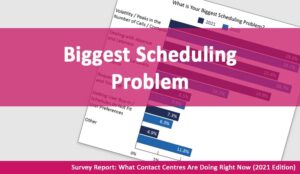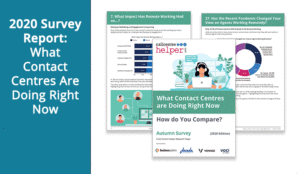We asked 294 contact centre professionals ‘What Is Your Biggest Scheduling Problem?’
This article is an extract from our ‘What Contact Centres Are Doing Right Now’ 2022 survey report, which was sponsored by NICE.
What Is Your Biggest Scheduling Problem?
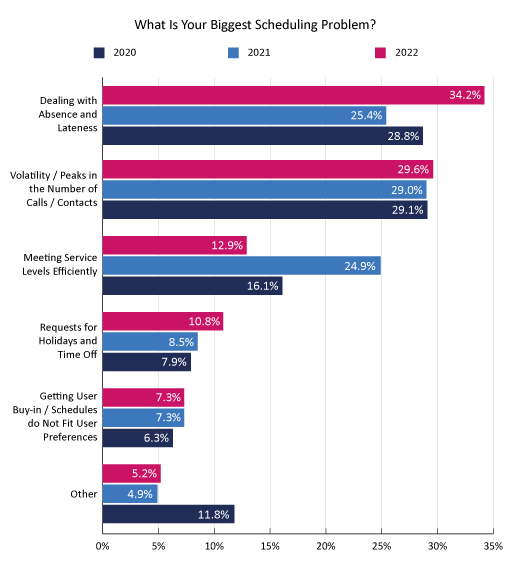
| Scheduling Problem | Response % |
|---|---|
| Dealing with Absence and Lateness | 34.2% |
| Getting User Buy-in / Schedules do Not Fit User Preferences | 7.3% |
| Meeting Service Levels Efficiently | 12.9% |
| Requests for Holidays and Time Off | 10.8% |
| Volatility / Peaks in the Number of Calls / Contacts | 29.6% |
| Other (please specify) | 5.2% |
Absence and Lateness Is Causing Scheduling Chaos
Absence and lateness has jumped 34.7% to the number-one problem contact centres face when scheduling staff, pushing forecast volatility from the top spot.
With this now standing at 34.2% from 25.4% last year, over a third of contact centres see this as their biggest scheduling problem.
This jump is due to a number of factors, but most likely is the impact of employee dissatisfaction and lack of engagement, and it could even be a warning sign that staff are looking to change jobs if their working environment is not what they are looking for.
On a potentially related note, 10.8% of contact centre professionals also stated that requests for holidays and time off is their top scheduling problem.
This 27% increase could be a result of the end of restrictions, which has meant many social events have been rescheduled and people are once again able to go away, so it may not be indicative of a morale problem.
With 5.2% of contact centre professionals choosing “other”, their responses indicate the most common issues are related to attrition and recruitment challenges which have led to understaffing.
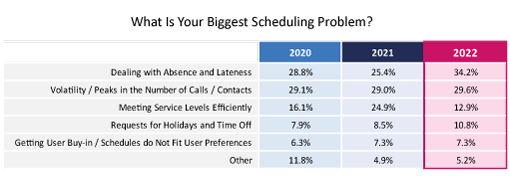
Contact Centres Have Risen to the Challenge
Contact centres appear to have made great strides in the last year, as problems with meeting service levels have dropped by 48.2% to 12.9%, and volatility has only increased by 2% from 29.0% to 29.6% in the last year.
As well as service delivery, contact centres also seem to be effectively getting user buy-in and user preference for schedules, as this has remained steady, with just 7.3% of contact centres citing this as their top scheduling problem.
Although this could be seen as a positive, the results do show that almost 63.8% of contact centres have put absence and lateness or volatility as their top scheduling problem.
With each of these having a knock-on effect on the others, contact centres need to focus on their employees to make sure they have the right staff, in at the right time, and that they treat them well.
This survey was done in partnership with NICE
Related Research
To download the full copies of our ‘What Contact Centres Are Doing Right Now’ survey reports follow the links below:
- What Contact Centres Are Doing Right Now (2023 Edition)
- What Contact Centres Are Doing Right Now (2022 Edition)
- What Contact Centres Are Doing Right Now (2021 Edition)
- What Contact Centres Are Doing Right Now (2020 Edition)
- What Contact Centres Are Doing Right Now (2019 Edition)
- What Contact Centres Are Doing Right Now (2018 Edition)
- What Contact Centres Are Doing Right Now (2017 Edition)
- What Contact Centres Are Doing Right Now (2016 Edition)
- What Contact Centres Are Doing Right Now (2015 Edition)
You can also download the full copies of our ‘Is Your Contact Centre Delivering Exceptional Customer Service?’ survey reports by following the links below:
- Is Your Contact Centre Delivering Exceptional Customer Service? (2020 Edition)
- Is Your Contact Centre Delivering Exceptional Customer Service? (2019 Edition)
- How Contact Centres Are Delivering Exceptional Customer Service (2016 Edition)
For more great information check out our other Contact Centre Research
Author: Robyn Coppell
Published On: 20th Jul 2023 - Last modified: 12th Aug 2025
Read more about - Contact Centre Research, Benchmarking, NiCE, Research





